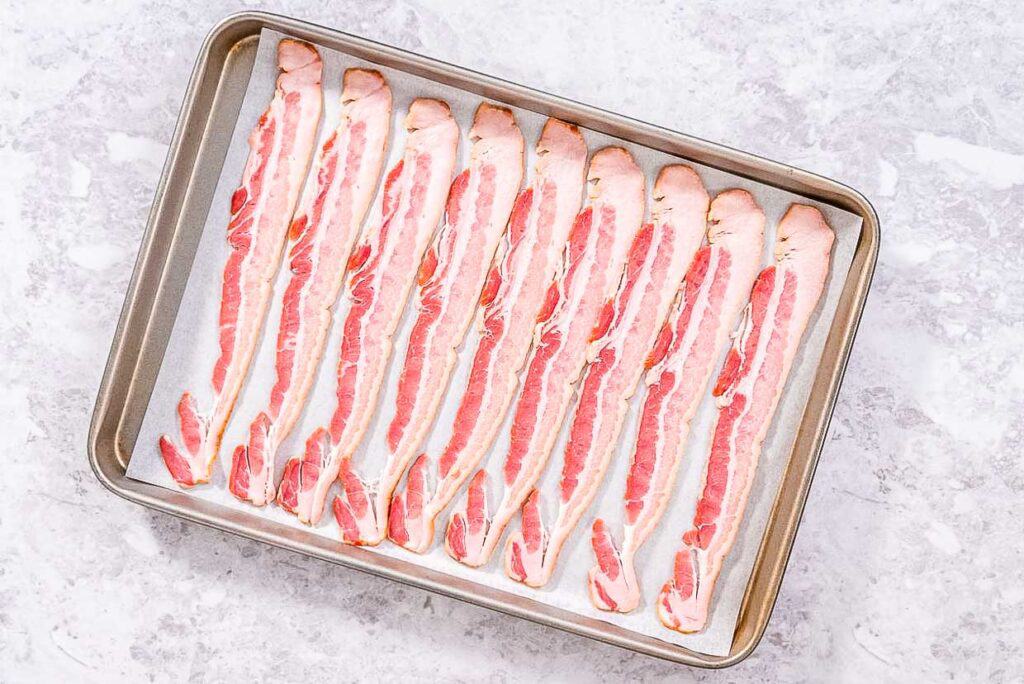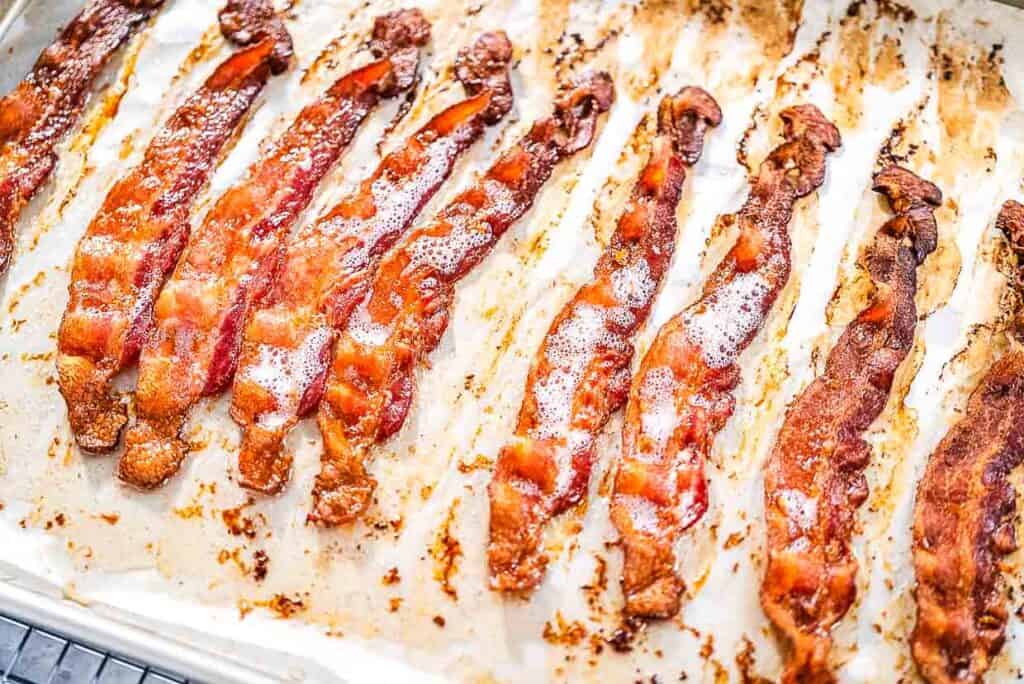Transform your breakfast game with the ultimate bacon hack: cooking it in the oven. No more grease splatters and no flipping required. In just a few simple steps, you’ll learn how to achieve the perfect crispy bacon every time, along with expert tips and creative seasoning ideas to elevate your morning routine.

Easy bacon for a crowd
Bacon is universally loved and goes with so many things. But the aftermath of stovetop frying? Cleaning up the kitchen after those little bits of popping oil scatter everywhere. What if you could skip all of that and get great bacon without using the stovetop?
Enter easy oven bacon. It’s so simple. No standing over a pan of hot grease, no flipping and all the splatters are contained inside the oven. Perfect for large batches with minimal mess, it’s a game-changer for breakfast or hosting a crowd.
Baking sheets and optional liners
To make oven bacon, you will need bacon, an oven and rimmed non-stick baking sheets. The baking sheets must be rimmed for safety to contain the bacon grease and prevent an oven fire. The non-stick aspect prevents the need for an additional liner that can affect cooking times, cost more money and create a bigger mess.
When it comes to how to prepare the baking sheet for your bacon, there are a few options. Some people swear by lining their baking sheets, while others swear by cooking directly on the pan. There is no one correct way to do it, so choose for yourself.
- Non-stick baking sheet with no rack or foil: The easiest and most straightforward option. The direct exposure between the metal pan and the bacon allows better heat transfer and quicker cooking times. As it’s non-stick, the bacon is easily released from the pan with the help of a metal spatula, and any baked-on bits soak off quickly in soapy water.
- Baking sheet with rack: For extra crispy bacon, this is a great option. It allows more air circulation around the bacon, so it gets a little crispier than it would while frying in its own bacon grease. However, cleaning the rack can be a pain. If you aren’t on a mission for ultra-crispy bacon, it may not be worth the additional cleanup effort.
- Baking sheet with aluminum foil or parchment: If you are not using a non-stick baking sheet, lining the pan with either foil or parchment can prevent the bacon from sticking. However, the bacon grease will seep under the liner, making nearly as much mess as cooking directly on the baking sheet. It will also slow down the cooking rate and you’ll end up with more trash, as the greasy foil or parchment cannot be recycled.
FDL’S 75 Best Bites

Our cookbook with 75 tasty recipes will be your go-to kitchen companion for easy dinners with ad-free recipes right at your fingertips. Crafted by experienced chefs and recipe developers, this collection offers a treasure trove of tried-and-true dishes that make mealtime a breeze.
Get the Recipe: FDL’S 75 Best Bites
How to cook oven bacon
This method is so simple and is the basis for bacon twists, bacon weaves and plain bacon strips. It works for all types of bacon, including thick-sliced, thin-sliced and center-cut. You can also use turkey bacon or vegan bacon strips. Just make sure to adjust the cooking time according to the packaging.
- Arrange the bacon: This should be done on a single layer on a baking sheet.
- Cook the bacon: Place the baking sheet in a cold oven, turn the oven to 400 F for crispy bacon and cook until done to your preference.
- Drain: While the bacon is in the oven, line a plate, cooling rack or large cutting board with a few layers of paper towels. Once the bacon is cooked to your liking, transfer it to the paper towels to drain and cool. Then serve and enjoy.

How long to cook for the best crispy bacon
Getting the crispiest bacon requires a hot oven, as the higher temperature helps engage the Maillard reaction more quickly. It’s easier to get the crispiest bacon with thin slices, but you can also do this with thick-sliced bacon. The times are estimates, and your oven may vary depending on how quickly it heats up.
- Thin-sliced crispy bacon: Start in a cold oven and cook at 400 F for 18 to 20 minutes.
- Thick-sliced crispy bacon: Start in a cold oven and cook at 400 F for 25 to 30 minutes.
Oven-baked bacon tips
For the best, perfectly cooked baked bacon, there are a few things to keep in mind. Following these tips will help you get great results the first time and every time.
- Do not preheat the oven: An important part of this recipe is that you should be putting the pan into a cold oven. A hot oven causes the bacon to shrink up, while a cold oven allows those bacon strips to stay longer and flatter. Pay attention to how quickly your oven heats and adjust the cooking time as needed.
- Bake in a single layer: The slices of bacon should all be in a single layer. They can be touching but not overlapping, or they will not cook evenly. Use multiple pans and rotate them halfway through if needed.
- Drain before serving: Bacon is not a sponge, so it won’t reabsorb the fat that renders out during the cooking process. However, pork fat, aka bacon grease, is solid when cooled, so if you let the bacon cool while sitting in the fat, it will stick to the bacon in white globs. To prevent this, transfer the hot bacon to a plate lined with paper towels and blot away any excess grease before serving.
Cleaning up leftover bacon grease
When making bacon, you are going to have leftover bacon grease. To quickly and easily handle the mess, clean it up while it’s still a warm liquid.
If your intention is to discard the bacon grease, carefully drain the grease from the pan into a coffee mug or ramekin and allow it to cool. Once solid, wipe the bacon grease out of the mug and into the trash using a silicone spatula or paper towel. You can then wash the pan with minimal effort. Never discard bacon grease or any other cooking oil down the drain.
If you wish to save the bacon grease, use it to add extra flavor when sauteeing onions and garlic or frying homemade omelets or swap it in for the cooking fat in any recipe that would benefit from the flavor of bacon. Strain the liquid bacon grease through a metal sieve to remove any bacon solids and store it in a resealable container. Glass canning jars work well. Store it in the back of your fridge and use it as needed.

Seasoning the bacon
As you know, bacon is plenty flavorful itself and needs no extra seasonings. However, it can be fun to try something different and experiment with new flavors — especially if you’re adding bacon to sandwiches or salads.
For savory options, sprinkle on dried herbs and ground spices that you would normally find in pork sausage. A combo of sage, thyme, rosemary and fennel mimics breakfast sausage, while garlic, onion, oregano and basil will give it a flavor profile similar to Italian sausage.
Looking for something a bit sweeter? Try rubbing the bacon with a combination of warming spices like cardamom, ginger and cinnamon, or go for a spice blend like pumpkin spice or apple spice. For a sweet and spicy treat mix three parts brown sugar with one part garam masala.
“Give bacon a spicy seasoning of paprika and garlic powder or a sweet twist of maple and Dijon mustard before arranging it on a wire rack and popping it in the oven. Oven bacon is my go-to cooking method because it is hands-off and rarely overcooked. I love saying goodbye to the greasy mess of stovetop frying.”
— Jessica Haggard, Primal Edge Health
Enjoying oven bacon
The art of oven bacon is an easy way to transform your breakfast routine while saying goodbye to stovetop mess and hello to consistently perfect, hassle-free bacon strips. With a little bit of knowledge, the right equipment and creative seasoning options, bacon in the oven will quickly become your go-to bacon cooking method.
Renee N Gardner is the creative mastermind behind Renee Nicole’s Kitchen, a recipe blog based on seasonal ingredients, dedicated to helping home cooks build their kitchen confidence to become home chefs. When Renee isn’t writing, developing recipes or photographing food, you’ll find her in the garden, traveling or enjoying the outdoors with her husband, son and two dogs.